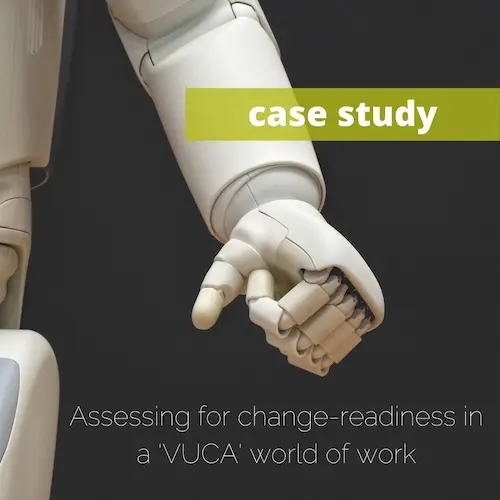Challenge:
The term VUCA, standing for Volatility, Uncertainty, Complexity, and Ambiguity, aptly describes the world of work we find ourselves in today. The 4th Industrial Revolution discourse places significant emphasis on technological advances, with the clear message that employees must upskill and adapt at an increasingly rapid speed if they want to remain relevant (and employable) in this era of accelerated technological progress. However, what has received less consideration is employees’ preferences and willingness to adapt.
Although it is accepted that change will have to occur for organisations to remain competitive, knowing which employees may be energised to drive change as well as which staff members are more hesitant towards change can provide your organisation with an additional edge – by getting the right people to implement change, as well as providing support for those more resistant to change. As such, JvR Psychometrics were approached by an organisation in the services industry to assist in determining the readiness of employees to adapt in times of ever-changing work demands.
Solution:
Employees (n=61) were assessed using the Myers-Briggs Type Indicator (MBTI) and Risk-Type Compass (RTC). The management team (n=10) was also asked to complete the High Performing Team Assessment (HPTA). The MBTI provides insights into individuals’ preferred styles of interacting with the world; the RTC assesses how individuals tend to perceive, approach, and manage risk. Lastly, the HPTA considers aspects of both performance and culture in enabling teams to work together effectively. These assessments were chosen since they consider employees’ natural inclinations without any emphasis on any specific workplace change and do not consider ability to change.
Application (employees):
The Introversion-Extraversion and Judging-Perceiving dichotomies as measured by the MBTI indicate individuals’ attitude towards change and as such, type can be used to help position reasons for change to allow for optimal engagement in the process. General characteristics of each dichotomy pair, and frequencies of these pairs as assessed in the organisation are indicated in the table below.
Dichotomy pair | Group characteristics |
IJ (60.0%) | Introspective, stable, will gradually change if adequate information and time |
IP (18.3%) | Flexible, enjoy variety, firm (even resistant) on what values/important |
EJ (6.7%) | Fast-moving, handle change effectively if they see practical value |
EP (15.0%) | Experience-seeking, energetic, embrace new opportunities, adapt most easily |
Approximately 73.7% of employees (Deliberate, Composed, Prudent, and Wary) would not actively approach risky situations, and as such, would likely prefer certainty and more gradual change with clear guidance throughout the change.
Risk Type | Characteristics |
Adventurous (9.8%) | Impulsive, excited by change, disregards tradition and convention |
Carefree (3.3%) | Unconventional, dislikes rules and routines, easily distractible |
Excitable (4.9%) | Attracted to risk, enjoy spontaneity, responds emotionally |
Intense (8.2%) | Anxious, worry about risk, alert to risks and threats |
Wary (16.4%) | Cautious and disciplined, prefer security, wants certainty |
Prudent (18.0%) | Prefers conventional methods, detail, and organisation, gradual change |
Deliberate (21.3%) | Self-confident, prefers plans and systematic approach, needs to be prepared |
Composed (18.0%) | Manages stress and pressure well, neither impulsive nor overly organised |
There were also significant correlations between Risk Type and the Introversion-Extraversion, Sensing-Intuition, and Judging-Perception dichotomies.
Employees with an Extraverted preference were significantly less likely to be Wary, Prudent, and Deliberate.
Employees with an Intuitive preference were significantly more likely to be Carefree, Excitable, and Intense, and less likely to be Prudent or Wary.
Employees with a Perceiving preference were significantly more likely to be Adventurous, Carefree, Composed, and Excitable, and less likely to be Deliberate, Prudent, and Wary.
Application (management):
Although the above profiles suggest that generally, employees inherently prefer continuity and stability, decisions made at management level ultimately determine whether processes of change will be rolled out and the manner in which they get implemented. The below tables indicate that there is diversity and a range of attitude preferences as well as risk types in the management group as well, suggesting that appropriate risks will be taken to ensure organisation growth and development, but not at the risk of the organisation’s stability. Given that type representation across employees and managers is also similar, employees are likely to feel more supported by management during times of change.
Dichotomy pair | Group characteristics |
IJ (50.0%) | Introspective, stable, will gradually change if adequate information and time |
IP (20.0%) | Flexible, enjoys variety, firm (even resistant) on what values/important |
EJ (10.0%) | Fast-moving, handle change effectively if they see practical value |
EP (20.0%) | Experience-seeking, energetic, embrace new opportunities, adapts most easily |
Risk Type | Characteristics |
Adventurous (30.0%) | Impulsive, excited by change, disregards tradition and convention |
Prudent (40.0%) | Prefers conventional methods, detail and organisation, gradual change |
Deliberate (10.0%) | Self-confident, prefers plans and systematic approach, need to be prepared |
Composed (20.0%) | Manages stress and pressure well, neither impulsive nor overly organised |
This group of managers also performed statistically significantly better on both the performance (M = 7.93, SD = 0.48), t(36) = 11.2, p = < .001, and cultural components (M = 8.02, SD = 0.50), t(36) = 13.1, p = < .001, compared to similar management groups; performance (M = 6.92, SD = 0.52), culture (M = 7.04, SD = 0.47), a trend that was also apparent across all 12 subscales.
Comparing the team to themselves then, when considering performance, their strongest areas were Meeting Effectiveness (possibly relating to the majority being Introverted Judgers) and Innovation (half of the team are adventurous or composed risk-takers). On the cultural component, the team were highest on Trust and Collaboration (possibly due to being an established team, but also, the Prudent and Deliberate IJ’s are also likely relied on to ensure that decisions aren’t made in haste).
Conclusion
The insights provided by the MBTI, RTC, and HPTA results assisted the organisation in determining how staff generally preferred to handle change. This in turn aided managers in positioning and approaching changing processes and procedures in a manner that was not perceived as threatening or intimidating to employees, as well as made them consider efforts that they could implement to support employees that may become overwhelmed with change.
Share this post
Newsletter
Get up-to-date industry news right in your inbox



